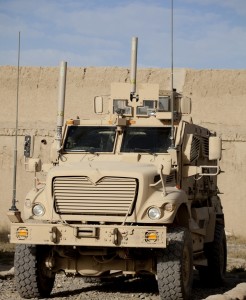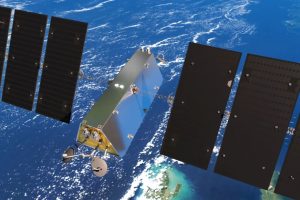
In the near future there will be unmanned cargo vehicles with autonomous driving systems that navigate via use of high-definition streaming video. Thus, the need for high-performance rugged interconnects on systems installed in military vehicles is increasing sharply.
Many of us recall the time when the most complicated electrical device on a tactical cargo vehicle was the indicator switch. There were also rudimentary fire-control systems in tanks many years ago, but they were stand alone, and radios back then were for voice communication only.
Troops relied on intercom systems, but data networks were just laboratory experiments at the time, and computers were pretty much of the mainframe variety. Connectors supporting these applications were strictly military-spec circulars, such as Mil-C-5015 and Mil-C-38999.
Interconnect density has increased by orders of magnitude over the years, and jumping ahead to today, network technology is now embedded in almost every on-board vehicle system. So it’s no surprise that military vehicles are becoming ever-more network intensive. Most new vehicles are now equipped with at least two separate networks.
One network is usually deployed for vehicle health and maintenance, based on CAN bus technology developed for the commercial vehicle world. Depending on the implementation, periodic reports are sent automatically on a vehicle’s status via a data link or are downloaded by maintenance personnel. These systems are used for predictive maintenance to prevent breakdowns by looking at component trends.
Take for example, a fuel pump: It may be operating within specifications, but the last three reports may show a steady down-trend in fuel pressure. Analysis software can pick this up and issue an alert, so maintenance personnel can address the problem before failure occurs.
The other network typically found on vehicles today is the operational or mission network. It’s the one that links vehicle computers, data links, radios, vision, and navigation systems directly involved in missions.
The networking technology is Ethernet, and most systems currently rely on 100-megabit systems. But gigabit Ethernet is making an appearance and has become the standard for vehicles currently on the drawing board.
The front line is also becoming data-intensive with high-definition streaming video, unmanned-aerial-vehicle sensor-data, and vehicle tracking. There is even advanced development for driverless vehicles that rely on high-definition video recognition to follow specified routes.
These systems would actually benefit from 10 gigabit Ethernet speeds, which would allow combat vehicles networked via data links to pinpoint each other’s position for perfect situational awareness.
These applications are all here now and being adapted to current vehicles, although there are issues of power and actual space for the systems. New vehicles will be designed to support these systems from the ground up.
So what’s the challenge for system interconnects? Surprisingly, connectors developed thirty years ago are still in use today. That’s because up until now, they have remained adequate. Analogue signals and low-speed digital signals work just fine with military 38999 circular connector cable assemblies, and system designers can be assured of continuing support and availability. In addition, end users are comfortable with the design.
But with the advent of the need for gigabit speeds, issues are beginning to appear. The standard military circular is not designed for high speed, and if equipped with special contacts, the circular requires a lot of panel space. With ruggedised RJ-45s, similar space issues are likely to emerge.
To take on this challenge, system manufacturers need to consider using industrial interconnect systems designed for Cat6A performance featuring compact sizes combined with rugged, IP69 environmental performance.
In addition to providing gigabit speed performance and holding up under harsh environmental conditions, interconnect systems must also offer advances in power, RF and even wireless – which enables Bluetooth in the crew compartment with wireless headsets.
Because there is no limit to the amount of abuse in tactical vehicle environments, all military vehicle system applications require very stringent environmental performance specs and must be mechanically rugged. When choosing the system interconnects, it’s best to select models that offer all or most of these features:
· Expanded operating temperature ranges with ability to dissipate internal and ambient heat
· High tolerance for shock, vibration and dust
· Corrosion resistance
· Waterproof – from splash resistance to immersion
· High bandwidth, speed and current capabilities for large data-volume processing
· Fibre optic, RF and flex circuit options
· Minimal usage of panel space
· Adequate power handling capability
As for the future of interconnects in military systems, look for more use of fibre optic solutions due to high bandwidth requirements and better immunity towards interference and jamming. High-power demands will also continue to rise so that alternative energy will become paramount as supplying energy is costly and high risk.
As of today, ruggedised interconnect solutions are essential to the success of alternative-energy applications. In the attempt to add custom-off-the-shelf solutions to networking systems, companies are looking at ruggedised versions of traditional commercial applications with high-speed I/O.
The military market now demands high electrical performance as well as rugged environmental performance. In many cases, interconnect systems are deficient on one aspect or the other.
Manufacturers of military vehicle systems need to make sure they rely on interconnects that offer both qualities. The end result will be mission systems that provide more and faster data to military personnel in the field so they can be more effective.
By relying on faster, smaller, lighter and cost-effective interconnects that also perform well in harsh conditions, manufacturers of on-board vehicle systems can also offer a wider range of technology and innovation to the military. Integrated and custom solutions can assist in achieving operational performance goals – with quality, efficiency and reliability – to ensure seamless connectivity in mission-critical applications.
Author is Stephen Webster, Industry Manager, Molex
 Electronics Weekly Electronics Design & Components Tech News
Electronics Weekly Electronics Design & Components Tech News



